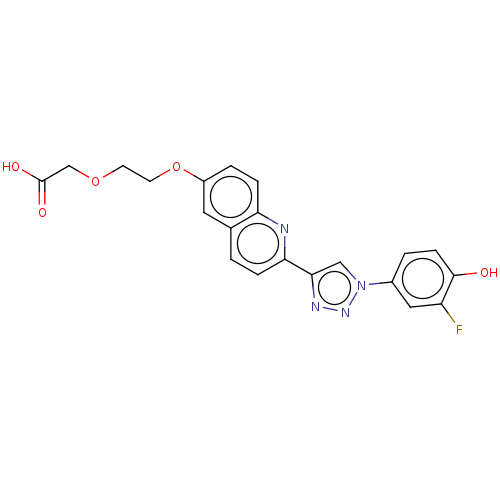

 Search and Browse
Search and Browse
 Download
Download
 Enter Data
Enter Data
BDBM50206062 CHEMBL3890541::US10968198, Example 44
SMILES: OC(=O)COCCOc1ccc2nc(ccc2c1)-c1cn(nn1)-c1ccc(O)c(F)c1
InChI Key: InChIKey=XZNCQKCYPSGTBS-UHFFFAOYSA-N
Data: 2 KI
| Target/Host (Institution) | Ligand | Target/Host Links | Ligand Links | Trg + Lig Links | Ki nM | ΔG° kcal/mole | IC50 nM | Kd nM | EC50/IC50 nM | koff s-1 | kon M-1s-1 | pH | Temp °C |
|---|---|---|---|---|---|---|---|---|---|---|---|---|---|
| Macrophage migration inhibitory factor (Homo sapiens (Human)) | BDBM50206062 (CHEMBL3890541 | US10968198, Example 44) | PDB MMDB KEGG UniProtKB/SwissProt B.MOAD DrugBank GoogleScholar AffyNet | CHEMBL PC cid PC sid UniChem | Article PubMed | 37 | n/a | n/a | n/a | n/a | n/a | n/a | n/a | n/a |
Yale University Curated by ChEMBL | Assay Description Inhibition of recombinant human MIF tautomerase activity expressed in Escherichia coli assessed as borate-enol complex formation using 4-hydroxypheny... | ACS Med Chem Lett 8: 124-127 (2017) Article DOI: 10.1021/acsmedchemlett.6b00451 BindingDB Entry DOI: 10.7270/Q2GQ70S5 | |||||||||||
| More data for this Ligand-Target Pair | |||||||||||||
| Macrophage migration inhibitory factor (Homo sapiens (Human)) | BDBM50206062 (CHEMBL3890541 | US10968198, Example 44) | PDB MMDB KEGG UniProtKB/SwissProt B.MOAD DrugBank GoogleScholar AffyNet | CHEMBL PC cid PC sid UniChem | US Patent | 45 | n/a | n/a | n/a | n/a | n/a | n/a | n/a | n/a |
Yale University US Patent | Assay Description Data obtained for the Example compounds, obtained using the methods described in Example B. | US Patent US10968198 (2021) | |||||||||||
| More data for this Ligand-Target Pair | |||||||||||||